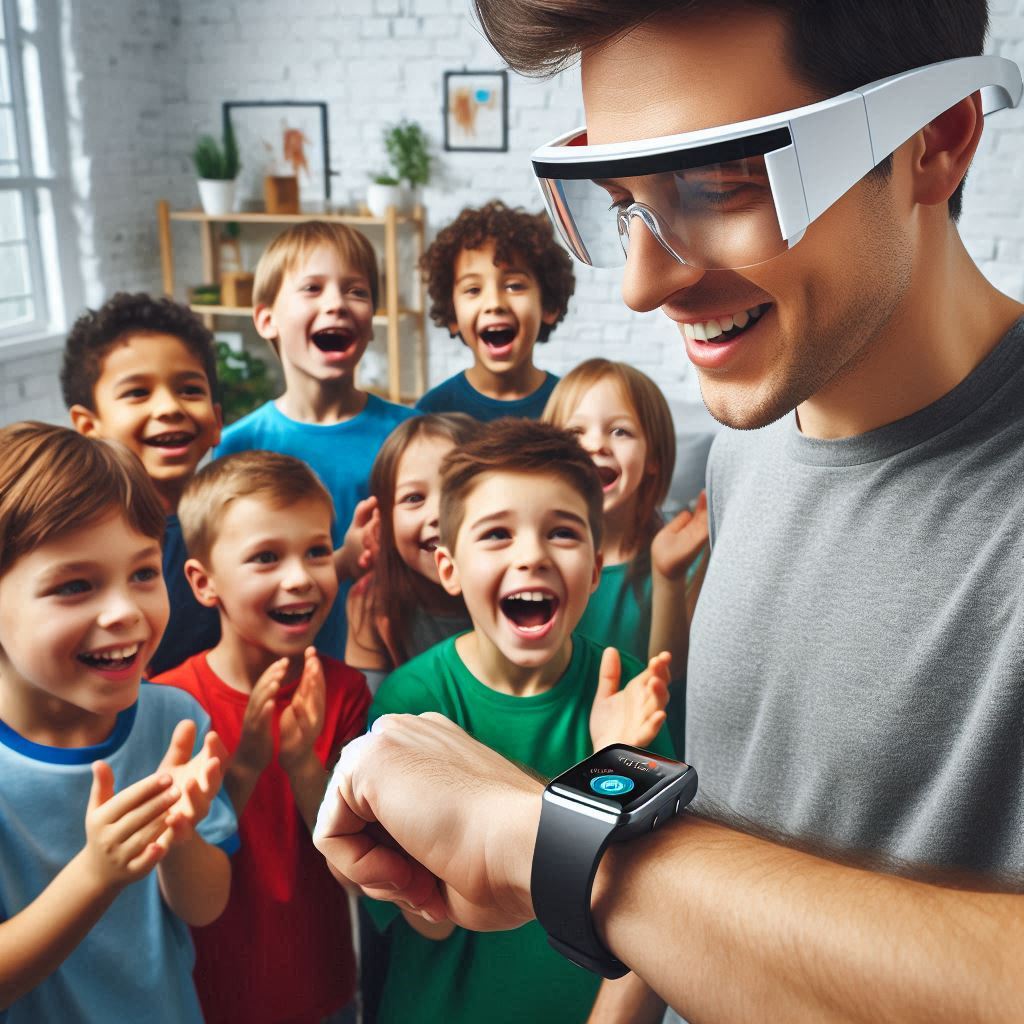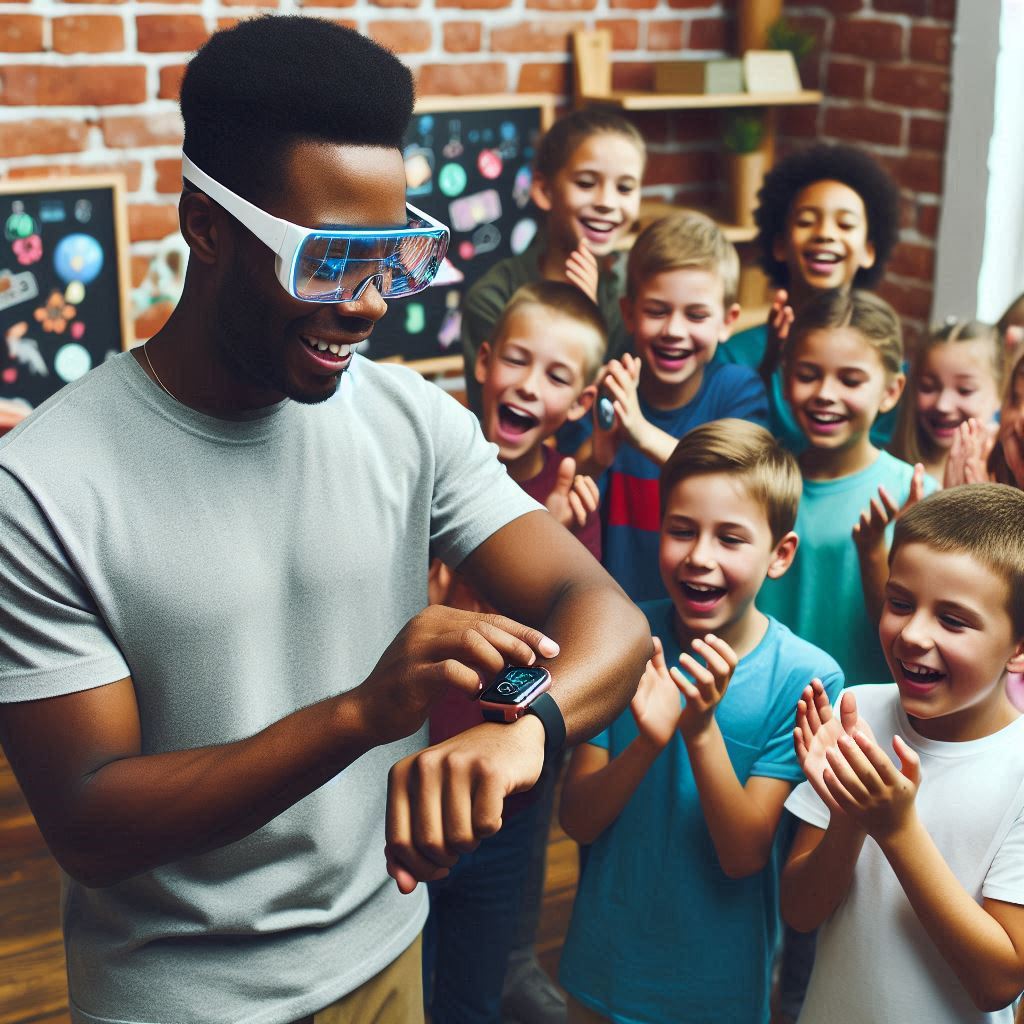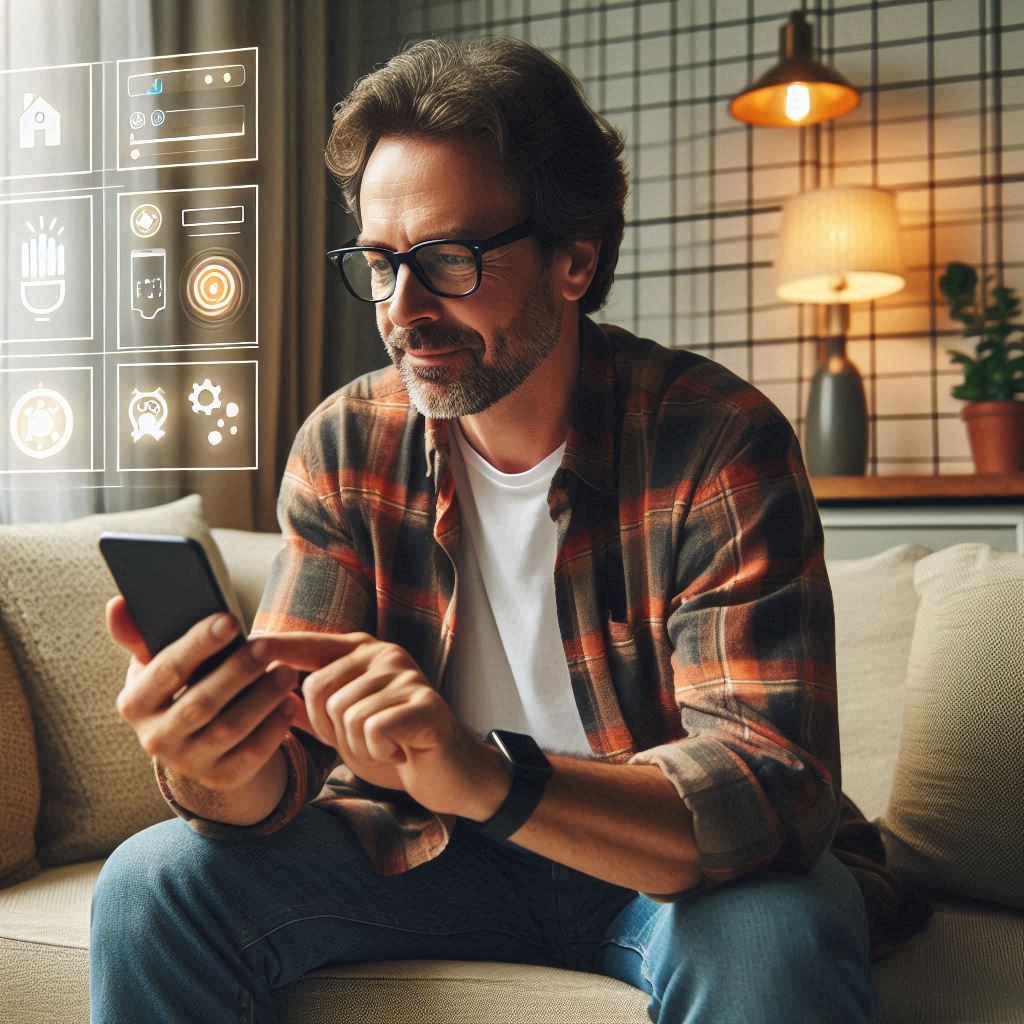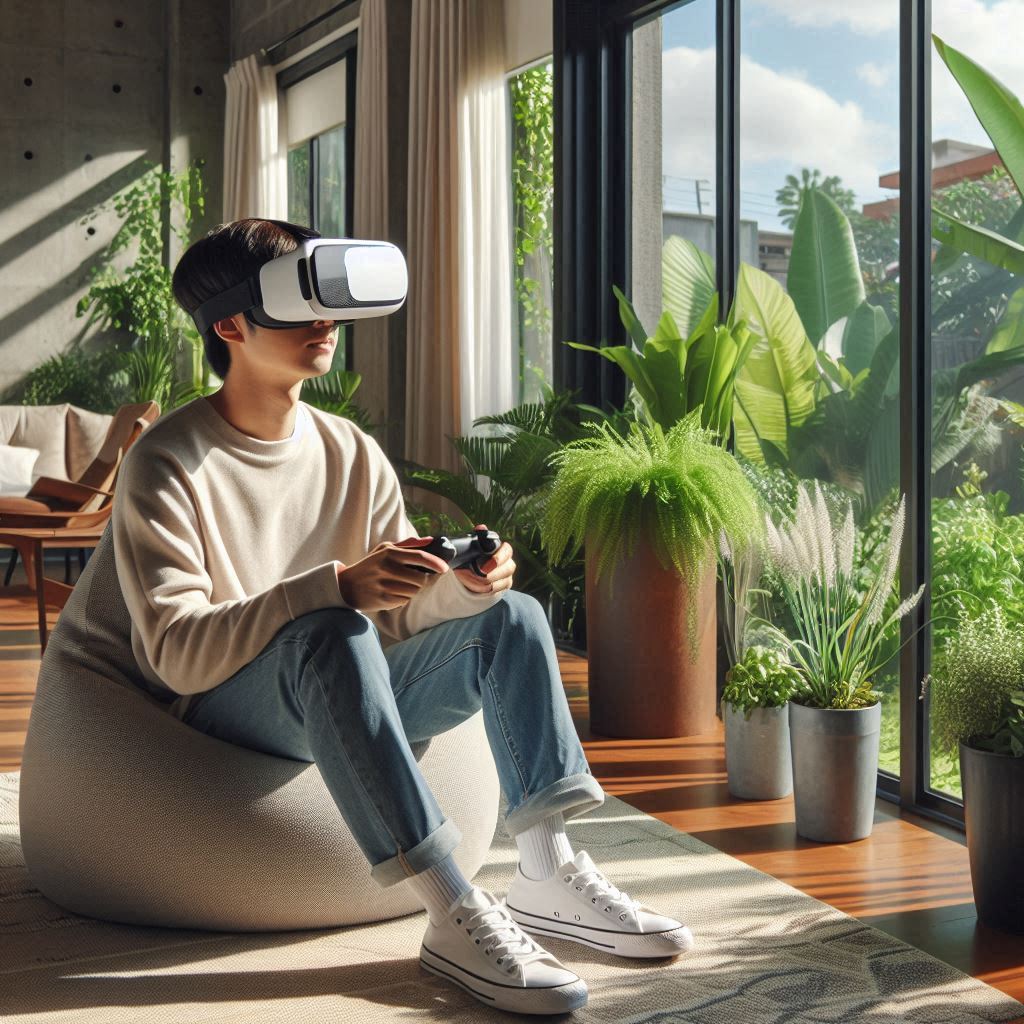Introduction
Smart wearables are electronic devices worn on the body.
They track health metrics and enhance daily activities.
These gadgets include smartwatches, fitness trackers, and smart clothing.
Definition of Smart Wearables
Smart wearables incorporate sensors, software, and connectivity features.
They collect data and offer real-time feedback.
Users interact with these devices through compatible apps on smartphones and tablets.
Overview of Their Evolution and Integration into Daily Life
Initially, wearables focused on fitness tracking.
Devices like pedometers paved the way for advanced features.
Today’s smartwatches monitor heart rates and manage notifications.
Technology continually integrates wearables into daily routines, making them indispensable.
The rise of the Internet of Things (IoT) has further propelled smart wearables.
They now communicate seamlessly with other devices and smart home systems.
This interconnectedness enhances their utility, providing users with a comprehensive view of their health and environment.
Importance of Personal Safety as a Growing Concern in Modern Society
In today’s fast-paced world, personal safety is a top priority.
Increased urbanization and technology dependence amplify safety concerns.
Wearable technology addresses these issues head-on by providing immediate solutions.
Smart wearables enhance personal safety through various features.
Many devices include emergency alert systems and location tracking.
These functions empower users to seek help when needed.
Moreover, users can share their location with trusted contacts for added security.
Furthermore, fitness trackers now include features for fall detection and health notifications.
This capability can alert emergency services swiftly if a wearer suffers a health crisis.
Overall, smart wearables aid in creating a safer living environment.
As smart wearables continue to evolve, expect even greater innovations.
Their role in personal safety will expand, integrating advanced technology for enhanced protection.
Therefore, these devices are not just trendy accessories; they are essential tools for safety in modern life.
Understanding Smart Wearables
Smart wearables are electronic devices designed to be worn on the body.
They blend technology with personal style and functionality.
These devices connect to the internet or other devices to share data in real time.
They offer diverse features that enhance personal safety and health monitoring.
Below, we explore what constitutes smart wearables.
What Constitutes Smart Wearables
Smart wearables come in various forms, each serving specific purposes.
Here’s a list of common types of smart wearables:
- Smartwatches: These are multifunctional timepieces that monitor health, receive notifications, and support apps.
- Fitness Trackers: These devices focus primarily on health metrics such as heart rate, steps, and sleep patterns.
- Safety Bracelets: Designed to enhance personal safety, these wearable devices often include emergency features.
- Smart Glasses: These glasses provide augmented reality experiences while tracking fitness and health.
- Smart Clothing: Incorporating sensors, smart clothing tracks physical activity and biometrics seamlessly.
- Wearable Cameras: Devices like action cameras allow users to record experiences hands-free.
- Health Monitors: These include devices that permanently monitor chronic conditions and share data with healthcare providers.
Key Features of Smart Wearables
Smart wearables offer various critical features that enhance their appeal and effectiveness.
The following points summarize these key features:
Put Your Tech Company on the Map!
Get featured on Nicholas Idoko’s Blog for just $50. Showcase your business, boost credibility, and reach a growing audience eager for tech solutions.
Publish Now- Connectivity: Smart wearables connect to smartphones, laptops, and other devices, facilitating seamless data sharing.
- Real-time Monitoring: Many wearables provide continuous health monitoring, delivering instant data feedback to users.
- Location Tracking: GPS-enabled wearables ensure effective tracking during outdoor activities or emergencies.
- Health Metrics: Smart wearables often track vital signs, including heart rate, blood pressure, and activity levels.
- Alerts and Notifications: Users receive instant alerts for messages, calls, and reminders through their wearable devices.
- Emergency Features: Many wearables include SOS buttons or fall detection, alerting specified contacts during emergencies.
- Long Battery Life: Most wearables are designed to last several days or even weeks on a single charge, enhancing usability.
- Durability: Many smart wearables are water-resistant or rugged, capable of handling daily wear and tear.
Now, let’s further explore how these features contribute to enhancing personal safety and improving everyday life.
The Impact of Smart Wearables on Personal Safety
Smart wearables represent a powerful tool for personal safety in various environments.
They provide users with advanced technology to stay connected and secure.
Here are some ways smart wearables enhance personal safety:
Emergency Response
Many smart wearables come equipped with emergency features.
Users can quickly alert authorities or loved ones in distress.
The SOS function sends location coordinates to emergency contacts.
This capability significantly improves response times in critical situations.
Health Monitoring
Real-time health monitoring enables users to maintain their well-being.
Wearables can detect irregular heart rates or other warning signs.
If the device identifies irregularities, it alerts the user, prompting them to seek medical help.
This proactive approach significantly improves health outcomes.
Location Awareness
Wearable devices equipped with GPS tracking enhance personal safety.
Users can track their movements in unfamiliar areas, reducing the risk of getting lost.
Parents can also monitor their children’s locations, giving them peace of mind.
Workout Safety
Fitness enthusiasts benefit from wearables that prioritize workout safety.
These devices track location, distance, and speed.
Many include features that automatically alert contacts if users do not return from a workout.
This capability promotes greater safety during outdoor activities.
Real-Life Applications of Smart Wearables
Numerous real-world examples illustrate how smart wearables improve personal safety.
These applications span various demographics and scenarios:
Young Adults
For college students navigating urban environments, smartwatches offer safety features.
Students can quickly call for help or share their location with trusted contacts.
These devices empower young adults to enhance their personal security on or off-campus.
Senior Citizens
Smart wearables cater to older adults, offering fall detection and health monitoring.
Caregivers receive alerts if a wearer falls, enabling a swift response.
Seniors maintain independence while ensuring their well-being through these technologies.
Children
Parents benefit from tracking devices designed specifically for kids.
Smart wearables ensure parents can locate their children at all times.
They often incorporate geofencing capabilities, which notify parents if a child leaves designated safe zones.
Outdoor Enthusiasts
Hikers and adventurers rely on smart wearables for navigation and safety.
These devices include maps and emergency contacts, promoting secure exploration.
With enhanced location tracking, outdoor enthusiasts can enjoy their hobbies more safely than ever.
Future Directions in Smart Wearables
The future of smart wearables looks promising and continually evolving.
Technological advancements will lead to more innovative features.
Put Your Tech Company on the Map!
Get featured on Nicholas Idoko’s Blog for just $50. Showcase your business, boost credibility, and reach a growing audience eager for tech solutions.
Publish NowHere’s what to anticipate in the upcoming years:
- Biometric Sensors: Future wearables may incorporate advanced sensors that track additional health metrics.
- Improved AI Integration: Wearables will increasingly utilize artificial intelligence for personalized health recommendations.
- Greater Interconnectivity: Expect enhanced connectivity with other smart devices and IoT technologies.
- Better Design and Comfort: Manufacturers will prioritize wearability and user comfort in future designs.
In fact, smart wearables offer invaluable tools for enhancing personal safety.
They enable users to monitor health, stay connected, and respond effectively in emergencies.
As technology progresses, these devices will become integral to everyday life, revolutionizing how we prioritize safety and well-being.
Read: Digital Minimalism: Balancing Tech Use for a Healthier Daily Life
The Role of Smart Wearables in Personal Safety
Overview of Safety Features in Smart Wearables
Smart wearables have fundamentally changed how people monitor personal safety.
These devices now come packed with features designed to enhance safety in daily life.
Let’s explore some critical safety functionalities offered by these smart devices.
GPS Tracking and Geofencing
GPS tracking represents one of the most vital advancements in wearable technology.
With real-time location tracking, wearables allow users and their loved ones to maintain a constant awareness of their whereabouts.
- Family members can track a user’s position during outdoor activities.
- Users can feel more secure knowing they can always be located.
- Many wearables support geofencing capabilities. Geofencing creates virtual boundaries, sending alerts when users venture beyond set limits.
- Organizations use geofencing to track employees in dangerous environments, enhancing workplace safety.
Wearable devices with GPS tracking can significantly reduce anxiety and fears related to safety in today’s world.
Emergency Alerts and SOS Functions
Emergency alerts and SOS features allow wearers to summon help instantly.
This capability serves as a crucial lifeline in urgent situations.
When activated, emergency alerts can initiate a call to emergency contacts or local authorities.
- Users can quickly call for help by pressing a button.
- Some devices include a loud alarm that attracts attention.
- Many wearables send pre-set messages to emergency contacts, informing them of the user’s situation.
- By sending location coordinates along with alerts, wearables enhance rescue efforts.
- These features empower users to take action promptly, helping individuals feel safer during potentially dangerous situations.
Health Monitoring and Fall Detection
Health monitoring has gained immense popularity, particularly with aging populations.
Wearables track various health metrics, such as heart rate and oxygen levels.
- These devices offer insights into users’ health and can prevent emergencies.
- Real-time monitoring can alert the user or medical professionals if health metrics fall beyond safe ranges.
- Fall detection is another essential feature for personal safety. When wearables detect a fall, they can trigger an automatic alert.
- Users can customize fall detection sensitivity based on their activity level.
- Wearables often track multiple falls to provide detailed information during emergencies.
- Most devices send alerts includes location details for responders.
Overall, these health-related features increase the confidence of wearers, particularly the elderly and those with chronic conditions.
Examples of Specific Devices Catered to Personal Safety
Various smart wearables have emerged in the market, each boasting unique features aimed at improving personal safety.
Below, we highlight some prominent devices explicitly designed with safety in mind.
Smartwatches
Smartwatches combine functionality with safety features, making them popular for users.
Leading smartwatches enhancing personal safety include:
Apple Watch Series 8
- Offers fall detection, emergency SOS, and marine-grade durability.
- Can share health data with emergency contacts in case of an emergency.
Fitbit Sense
- Monitors heart rate variability and can detect irregular heart rhythms.
- Emergency SOS can connect users to local authorities at the touch of a button.
Garmin Venu 2
- Provides advanced health monitoring features including heart rate and stress levels.
- Offers incident detection that alerts emergency contacts during workouts.
Fitness Trackers
Fitness trackers have evolved into powerful safety tools beyond just fitness monitoring.
Consider these models focusing on safety:
Xiaomi Mi Band 6
- Affordable, lightweight fitness tracker with heart rate monitoring and stress management features.
- Alerts users about notifications, ensuring they stay connected.
WHOOP Strap 3.0
- Provides continuous health monitoring, activity tracking, and strain analysis.
- Users can share data with coaches or medical personnel for emergency insights.
Dedicated Personal Safety Devices
These devices focus solely on personal safety rather than fitness tracking.
Popular options include:
Invoxia GPS Tracker
- A compact device that combines GPS, geofencing, and anti-theft features.
- Ideal for keeping track of belongings, pets, or even children.
Safelet Smart Bracelet
- A smart bracelet designed explicitly for emergency alerts.
- Users can tap the bracelet to notify selected contacts, sharing their GPS location.
Revolar Instinct
- A compact device that allows users to send alerts with location data at the press of a button.
- Offers discreet communication in times of distress.
Smart wearables have transformed personal safety into a tech-enabled realm.
GPS tracking, emergency alerts, and health monitoring seamlessly blend into our daily lives.
Devices cater to various needs, allowing users to select systems that work for them.
As technology advances, personal safety through wearables will continue to evolve.
Individuals will become increasingly empowered to monitor health and respond to emergencies.
Investing in smart wearables serves as a smart decision for those looking to enhance their personal safety.
These devices bring peace of mind, encouraging users to engage in life’s adventures with renewed confidence.
Read: AI-Driven Wellness: How Artificial Intelligence Enhances Mental Health

Impact on Everyday Life
Case Studies of Users Benefiting from Smart Wearables in Safety
Smart wearables have significantly transformed personal safety in everyday life.
Numerous case studies highlight their impact.
Put Your Tech Company on the Map!
Get featured on Nicholas Idoko’s Blog for just $50. Showcase your business, boost credibility, and reach a growing audience eager for tech solutions.
Publish NowThese real-life examples illustrate how various individuals enhance their safety through innovative technology.
Case Study 1: Emergency Alert Systems for Seniors
In 2022, an elderly woman named Margaret fell at home.
She wore a smartwatch equipped with an emergency alert feature.
The device automatically detected her fall and sent an alert to her son.
Within minutes, he arrived to help.
Margaret credits the wearable with saving her life by ensuring quick assistance.
Case Study 2: Safety Tracking for Children
A school in Los Angeles implemented GPS-enabled smartwatches for children.
Parents can track their kids during school hours.
One parent reported feeling relieved when the school went on lockdown.
She quickly checked her child’s location on the app, confirming safety.
Case Study 3: Outdoor Enthusiasts and Location Sharing
Outdoor adventure enthusiasts frequently use smart wearables.
Adam, an avid hiker, wore a smartwatch with location sharing capabilities.
When he got lost while hiking, his partner accessed his real-time location.
They coordinated his rescue, demonstrating how wearables aid in emergencies.
Analysis of Demographic Groups and Their Specific Needs
Different demographic groups have unique safety needs that smart wearables address effectively.
Let’s explore the specific requirements of these groups.
Children
Parents prioritize their children’s safety.
Smart wearables designed for kids often include GPS and SOS features.
These devices allow parents to:
- Track their child’s location in real-time.
- Set geofencing alerts to know when kids leave designated areas.
- Communicate with children immediately through call or message features.
Elderly
The elderly population has specific challenges regarding safety.
Smart wearables designed for seniors focus on fall detection and health monitoring.
Such devices help seniors:
- Receive immediate alerts in case of a fall.
- Monitor heart rate and other vital signs in real-time.
- Communicate easily with emergency services or family members.
Outdoor Enthusiasts
Outdoor enthusiasts face unique safety risks.
Smart wearables cater to their adventurous lifestyle by offering features like:
- Built-in GPS and mapping to navigate unfamiliar terrain.
- Emergency SOS buttons to call for help when needed.
- Barometric altimeters for elevation tracking.
Individuals with Health Conditions
People with specific health conditions greatly benefit from smart wearables.
These devices provide features such as:
- Continuous blood glucose monitoring for diabetics.
- Alerts for abnormal heart rates.
- Medication reminders to ensure adherence to treatment plans.
Challenges and Considerations
While smart wearables greatly enhance safety, challenges remain.
Users must be aware of potential issues.
Addressing these concerns leads to better user experiences.
Privacy Concerns
- Data privacy tops the list of concerns for users.
- Smart wearables collect sensitive information.
- Users must choose devices with robust privacy policies.
- Devices should encrypt data and allow users control over their information.
Battery Life
- Smart wearables rely on battery life for optimal performance.
- Users often face issues with devices running out of battery.
- Manufacturers must prioritize long-lasting batteries and efficient charging solutions.
Technological Literacy
- Some demographic groups may struggle with technology.
- Elderly users, in particular, may find it challenging to navigate devices.
- Manufacturers should focus on user-friendly interfaces and provide comprehensive guides for all age groups.
The Future of Smart Wearables in Personal Safety
The future of smart wearables looks promising.
Continuous advancements in technology will enhance these devices further.
Innovators are exploring new features that cater to growing safety needs.
Integration with AI
- Artificial intelligence can improve wearables’ functionalities.
- Advanced algorithms may analyze user data for better predictive safety alerts.
- For instance, an AI-enabled device could predict potential falls based on activity patterns.
Increased Customization
- Future devices will offer greater customization.
- Users can tailor wearable features to align with their specific needs.
- This could include personalized safety alerts and health monitoring settings.
Community Connection
- Wearables could enhance community engagement.
- Devices might include features that allow users to connect with nearby community members during emergencies.
- This could lead to faster response times in critical situations.
Read: AI Tools for Entrepreneurs: Streamlining Daily Life for Business Owners
Comparison with Traditional Safety Measures
How Smart Wearables Differ from Traditional Safety Tools
Smart wearables have transformed personal safety.
They provide features and functions that traditional safety tools cannot match.
Put Your Tech Company on the Map!
Get featured on Nicholas Idoko’s Blog for just $50. Showcase your business, boost credibility, and reach a growing audience eager for tech solutions.
Publish NowHere are key differences between smart wearables and conventional safety devices:
- Real-time monitoring: Smart wearables continuously track your location and health metrics. Traditional tools like pepper spray do not provide ongoing alerts or updates.
- Multi-functionality: Many wearables combine various safety features. For example, some devices provide GPS tracking, emergency alerts, and health monitoring all in one solution.
- Automatic alerts: When a smart wearable detects danger, it can automatically alert emergency services or designated contacts. Traditional tools usually require manual activation.
- User-friendly designs: Smart wearables often blend seamlessly into your daily life. They resemble everyday accessories, while traditional tools may draw unwanted attention.
- Data integration: Wearable technology can integrate with smartphones and apps. This feature allows users to manage safety alerts and health data conveniently.
Advantages of Using Technology for Safety Over Conventional Methods
Adopting smart wearables for personal safety offers numerous benefits.
This cutting-edge technology surpasses traditional safety measures in several ways.
Here are some advantages of using smart wearables:
- Enhanced situational awareness: Wearables improve your understanding of your surroundings. They can send alerts if you stray from a certain area or enter a dangerous zone.
- Discreet design: Many smart wearables look like regular accessories. This discreet design allows you to maintain your privacy while ensuring safety.
- Health monitoring features: Certain smart wearables track vital signs like heart rate and stress levels. This feature enables proactive health management alongside personal safety.
- Community support: Some wearable devices connect you to a network of users. This feature provides instant support during emergencies, increasing feelings of safety.
- Customizable alerts: You can set personalized alerts based on your safety preferences. Smart wearables allow users to tailor the experience to their unique needs.
- Long-lasting battery life: Most smart wearables boast extended battery lives. This advantage ensures that your safety device remains operational throughout the day.
- Remote access: Many wearable devices enable remote access to safety features. Users can manage alerts and notifications through their smartphones, providing further convenience.
- Predictive capabilities: Some smart wearables utilize artificial intelligence. They can predict potential safety risks based on user behavior and alerts.
- Integration with health data: Smart wearables often integrate health and safety features. This combination allows users to manage both their well-being and personal safety in one device.
- Emergency location sharing: Many smart wearables feature built-in GPS. This function allows users to quickly share their location during emergencies, ensuring faster responses.
Summary of Benefits
Smart wearables have revolutionized personal safety in multiple ways.
Their continuous monitoring, integrated functions, and real-time alerts surpass conventional tools like pepper spray and alarms.
By providing discreet designs and user-friendly interfaces, they encourage wider adoption without sacrificing style.
Their community support and remote access create a sense of belonging and reassurance.
Features like health monitoring improve overall well-being, turning safety devices into holistic personal management tools.
As smart wearables continue to evolve, they will likely encompass even more innovative safety measures.
Embracing this technology opens new avenues for improving personal safety in our increasingly complex world.
Read: The Impact of Smart Cities on Urban Living: A Guide for City Dwellers
Challenges and Limitations
Smart wearables have transformed the way individuals approach personal safety.
However, as with any technological advancement, they bring challenges and limitations.
Here, we delve into the potential security and privacy concerns as well as the technological constraints affecting usability and effectiveness.
Potential Security and Privacy Concerns
Smart wearables collect significant amounts of personal data.
This data can include health metrics, location information, and daily activity patterns.
Such extensive data collection raises various security and privacy questions:
- Data Breaches: Hackers can target wearable devices and the associated apps. If these devices are compromised, users risk losing sensitive information.
- Location Tracking: Many wearables offer GPS tracking. If this data falls into the wrong hands, it could lead to stalking or unwanted surveillance.
- User Consent: Often, users do not fully understand what they consent to. This misunderstanding can lead to unknowingly allowing data-sharing practices.
- Third-party Access: Many apps connected to wearables share data with third parties. These companies might not have the same data protection standards.
- Insecure Communication: Wearables often communicate over wireless networks. If these networks are not secure, attackers can intercept information.
Addressing these concerns requires increased awareness and proactive measures from manufacturers and users:
- Manufacturers need to implement robust encryption practices.
- Users should frequently update their device software to patch vulnerabilities.
- Read privacy policies carefully to understand data usage.
- Activate security features, such as two-factor authentication when available.
Limitations in Technology
In addition to privacy concerns, several technological limitations hinder the full effectiveness of smart wearables:
- Battery Life: Many wearables operate on limited battery capacities. Frequent charging can be cumbersome for users who rely on these devices for safety.
- Network Issues: Smart wearables depend on internet connectivity. In areas with poor connectivity, features may not work optimally, compromising safety.
- Device Compatibility: Some wearables are not compatible with every smartphone or platform. Users may need to invest in specific devices to utilize safety features.
- Limited Functionality: While many wearables come with built-in safety features, some functionalities can be too basic.
This limitation may not provide users with the comprehensive safety measures they desire. - Wearable Dependency: Users may become overly reliant on their devices. In emergencies where the device fails, it can lead to dangerous situations.
To counter these limitations, consumers should stay informed about the capabilities of their devices:
- Choose wearables with extended battery life options or those that offer charging solutions.
- Research connectivity requirements before purchasing a wearable.
- Select devices that align with your existing technology for seamless integration.
- Stay updated with technological advancements to leverage newer features.
In short, while smart wearables are revolutionizing personal safety, challenges remain.
Users must navigate privacy risks and technology limitations.
By staying informed and proactive, individuals can maximize the benefits of these innovative devices while minimizing potential downsides.
With careful selection and vigilant use, smart wearables can significantly enhance personal safety in everyday life.
The Future of Smart Wearables in Personal Safety
The advancement of technology constantly reshapes our daily lives.
Among these innovations, smart wearables are increasingly vital.
They enhance our personal safety in numerous contexts.
In the coming years, wearable technology will continue to evolve, bringing exciting innovations.
This section explores anticipated developments and predictions for smart wearables in personal safety.
Innovations on the Horizon in Wearable Technology
As we move forward, several innovations will likely revolutionize wearable technology.
These advancements aim to improve functionality, efficiency, and accessibility.
Here are some trends to watch for:
- Advanced Sensors: Future wearables will integrate sophisticated sensors. These sensors will monitor various health metrics continuously.
- AI Integration: Artificial intelligence will enhance wearables significantly. AI can analyze data in real time, providing timely insights for users.
- Improved Battery Life: Developers will focus on extending battery life in wearables. Longer-lasting power sources will ensure devices remain functional throughout the day.
- Seamless Connectivity: The integration of 5G technology will allow wearables to connect more effectively. High-speed connectivity will improve data transfer between devices.
- Wearable Tech and IoT: Combining wearables with IoT (Internet of Things) ecosystems will create interconnected networks. This synergy can enable proactive safety measures for users.
- Enhanced Design: Aesthetic considerations will drive designs that make wearables more appealing. Attractive styles will encourage more people to use these technologies.
These innovations will create a new generation of smart wearables designed with personal safety at the forefront.
Users can expect devices that monitor their environment as much as their personal health.
Put Your Tech Company on the Map!
Get featured on Nicholas Idoko’s Blog for just $50. Showcase your business, boost credibility, and reach a growing audience eager for tech solutions.
Publish NowPredictions about How Smart Wearables Will Further Evolve to Enhance Personal Safety
As we look toward the future, several predictions emerge about the evolution of smart wearables.
These predictions emphasize safety enhancements and more integrated use cases.
Consider these possibilities:
- Emergency Alert Systems: Wearables will feature more robust emergency alert systems. Users will be able to send distress signals with a simple gesture.
- Real-time Health Monitoring: Wearables will continuously track vital signs. This information will alert users about potential health threats.
- Environmental Hazard Detection: Future devices could detect environmental hazards. Features might include air quality monitoring and UV light detection.
- Personal Safety Zones: Wearables may establish safety zones using GPS. The system can send alerts if an individual wanders out of these areas.
- Wearable Communication Devices: Innovations may lead to more advanced communication features. Two-way communication could allow users to connect with emergency services quickly.
- Smart Wearables for Children: Families may increasingly equip children with safety wearables. These devices can track locations and send alerts if a child feels unsafe.
- Integration with Smart Home Devices: Wearables might seamlessly connect with smart home technology. Users can control home security systems from their wrist, enhancing safety.
These predictions indicate a shift toward more comprehensive safety solutions.
As wearable technology advances, they will become indispensable tools in personal safety management.
The Role of Data Security in Wearable Safety Solutions
As wearables become integral to personal safety, data security will become increasingly vital.
Safeguarding user data must be a top priority.
Here are some considerations for developers and users alike:
- User Privacy: Wearables collect sensitive data, including health information. Protecting this information is crucial to maintaining user trust.
- Secure Connections: All data transferred between wearables and other devices must remain encrypted. Utilizing robust encryption methods can mitigate risks of unauthorized access.
- Regular Software Updates: Manufacturers should provide frequent updates. These updates can address vulnerabilities and boost security for users.
- User Control: Allowing users more control over their data will empower informed decision-making. Options for data sharing and privacy settings should be transparent.
By prioritizing these aspects, wearables can not only help users feel safe but also protect their data integrity.
The Path Forward
In summary, the future of smart wearables in personal safety is undeniably bright.
Innovations on the horizon promise to change the landscape of how we approach safety daily.
As technology evolves, predictions indicate a dynamic environment for wearables, enhancing user experience and safety.
With every advancement, we move closer to a world where personal safety is seamlessly integrated into our daily lives.
The continuous evolution of wearable technology will empower individuals to live confidently, knowing they have state-of-the-art tools for protection at their fingertips.
Devices will not just be accessories but essential companions that ensure safety, wellness, and peace of mind.
Conclusion
Recap of the importance of smart wearables in revolutionizing personal safety
Smart wearables significantly enhance personal safety in our daily lives.
These devices provide real-time data and alerts, promoting proactive responses to potential threats.
Users can customize settings to fit their specific safety needs.
For instance, smartwatches can monitor heart rates and detect falls, alerting emergency contacts immediately.
Additionally, many smart wearables feature location tracking.
This capability allows loved ones to monitor a person’s whereabouts.
In emergency situations, users can share their location with just a few taps.
Furthermore, some devices include SOS buttons for quick alerts, adding another layer of security.
Call-to-action to consider how they can integrate smart wearables into their own safety practices
Wearables also encourage healthier lifestyles, which fosters personal safety.
Regular activity tracking motivates users to remain active and engaged.
Improved physical health can lead to a heightened sense of well-being.
When people feel better, they often make safer choices in daily interactions.
As technology evolves, so too, the potential for smart wearables to improve safety increases.
New innovations may include advanced sensors and improved connectivity.
Future devices could integrate AI for predictive analysis of safety threats.
This proactive approach to personal safety can truly change lives.
Final thoughts on embracing technology for a safer everyday life
Embracing technology opens doors to a more secure everyday life.
By integrating smart wearables, individuals can take charge of their safety.
Awareness of the features and functions of these devices can empower users.
With a little research, anyone can find the right wearable to fit their lifestyle.
Put Your Tech Company on the Map!
Get featured on Nicholas Idoko’s Blog for just $50. Showcase your business, boost credibility, and reach a growing audience eager for tech solutions.
Publish NowConsider how you can incorporate smart wearables into your safety practices.
Evaluate your daily routines and assess areas where wearables can enhance protection.
Whether it’s for fitness, medical alerts, or personal security, these devices can play a crucial role.
Ultimately, making informed choices can lead to a safer, healthier life.
Before You Go…
Hey, thank you for reading this blog post to the end. I hope it was helpful. Let me tell you a little bit about Nicholas Idoko Technologies.
We help businesses and companies build an online presence by developing web, mobile, desktop, and blockchain applications.
We also help aspiring software developers and programmers learn the skills they need to have a successful career.
Take your first step to becoming a programming expert by joining our Learn To Code academy today!
Be sure to contact us if you need more information or have any questions! We are readily available.
[E-Books for Sale]
1,500 AI Applications for Next-Level Growth: Unleash the Potential for Wealth and Innovation
$5.38 • 1,500 AI Applications • 228 pages
Are you ready to tap into the power of Artificial Intelligence without the tech jargon and endless guesswork? This definitive e-book unlocks 1,500 real-world AI strategies that can help you.
See All 1,500 AI Applications of this E-Book
750 Lucrative Business Ideas: Your Ultimate Guide to Thriving in the U.S. Market
$49 • 750 Business Ideas • 109 pages
Unlock 750 profitable business ideas to transform your future. Discover the ultimate guide for aspiring entrepreneurs today!
See All 750 Business Ideas of this E-Book
500 Cutting-Edge Tech Startup Ideas for 2024 & 2025: Innovate, Create, Dominate
$19.99 • 500 Tech Startup Ideas • 62 pages
You will get inspired with 500 innovative tech startup ideas for 2024 and 2025, complete with concise descriptions to help you kickstart your entrepreneurial journey in AI, Blockchain, IoT, Fintech, and AR/VR.
We Design & Develop Websites, Android & iOS Apps
Looking to transform your digital presence? We specialize in creating stunning websites and powerful mobile apps for Android and iOS. Let us bring your vision to life with innovative, tailored solutions!
Get Started Today




